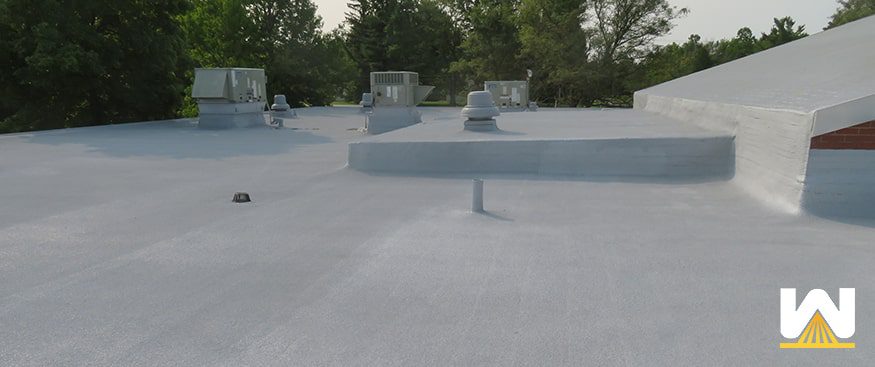Do you know what the best benefit of a seamless roofing system is?
They have no seams!
If you’ve been in the commercial roofing game for a long time, you know the headaches that a roof with seams can cause.
The most common flaw is that the seams lose adhesion, which allows water an opportunity to enter your roof insulation.
Even a tiny loss of adhesion can allow enough water to enter your insulation to the point where it enters your roof deck and causes a leak.
Say that you do have a leak.
Where is water entering your roof system?
Having a roofing system with seams makes it very difficult to identify where the slightest loss of seam adhesion is occurring.
You didn’t think you’d go up on your roof and see a 10ft. by 10ft. rubber sheet folded over, did you?
If only it were that easy.
In this article, we’ll describe two different types of seamless commercial roofing systems. We’ll also explain which type is best for your existing roof.
West Roofing Systems has been installing seamless roofing systems on commercial roofs since 1979.
And since that time, we’ve explained the benefits of seamless roofing systems to property owners, which seamless system is the most cost-effective choice for their building…and why?
Let’s get started.
Two types of seamless roofing systems
Here’s a quick introduction to two different seamless roofing systems.
Silicone Restoration Membranes
Also known as silicone roof coatings, is a single layer (applied in one or two coats) of silicone that’s rolled or sprayed on as a liquid to fill in cracks, blisters, and seams.
The process does not improve the insulation or underlying system, but it does add an extra layer of protection from the elements.
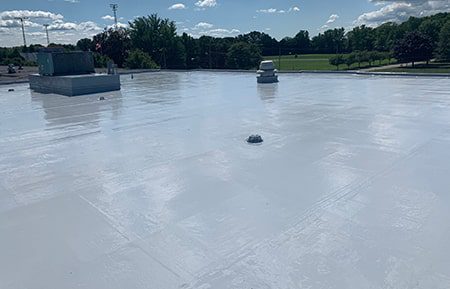
Spray Polyurethane Foam
Spray Polyurethane Foam Roofing, is a material that’s sprayed as a liquid that expands into a foam, creating a solid layer of fully-adhered insulation across an existing roof.
The usual application of spray foam is to repair and reinvigorate an existing roof by removing the saturated areas (if any), replacing with like materials, and then spraying foam over top of the entire roof.
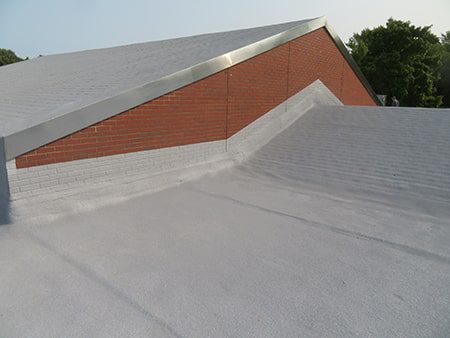
Which seamless roofing system is best for my building?
Now that you’ve learned a little about each system, which one is right for your building?
The best system for your roof depends on the existing conditions of your roof.
Here are some questions a commercial roofing contractor will find out about your roof:
- How much of your insulation is saturated with water?
- How many roof systems are currently in place?
- How much longer do you need the roof to last?
- How healthy are the seams on your roof?
- How much are you trying to reduce your energy savings?
We’ll go through each of these below and tell you which seamless roofing system is best for your building.
How much of your insulation is saturated with water?
A roofing contractor may perform an infrared roof inspection to determine how much water has saturated your insulation.
The reason they do this is that you never want to install a roofing system over wet insulation. Installing over a wet area keeps water in your system which can eventually leak, and it may cause issues with the newly installed system.
The water left behind has two ways to go, up or down. Up, and it can damage the newly installed roofing system with adhesion issues or when the water evaporates. Down, and the water may have a chance to enter your building.
Imagine paying thousands of dollars for a new roof that looks spectacular and it leaks. Installing over wet insulation is most likely how this happens.
The industry standard is if your roof has more than 25% saturation, it’s cost-effective to tear everything off and start over. In this case, installing a spray foam roof would be most beneficial.
If your roof has less than 25% saturation, it’s most likely cost-effective to only remove the saturated areas, replace those areas with new, dry materials, and then decide on which seamless system is best for you.
How many roofing systems do you already have?
Per building codes, a commercial roof can have a maximum of two roofing systems.
A roofing contractor will determine how many roofing systems there are through a visual inspection and by possibly pulling core samples, like this:
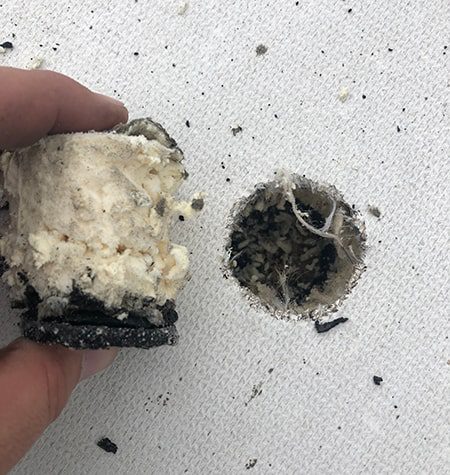
If you have two or more roofing systems, your best bet is to go towards the silicone restoration system because it’s considered maintenance…and not another roofing system.
However, there are some restrictions about which roofs are eligible for silicone roof coating systems, such as:
- The roof typically has 25% or less saturation
- The seams are in relatively good shape
- There’s been routine maintenance on the roof
If you only have one roofing system, you can legally install either roofing system.
How much longer do you need the roof to last?
A popular phrase is that a spray foam roof can be the last roofing system you’ll ever need to install.
This is because a spray foam roof is renewable.
When the coating that protects a spray foam roof wears off, you simply clean the roof, install more coating and the warranty is renewed.
A silicone roof coating system works the same way.
However, if you only need your building to be leak-free for 5-15 years, you may want to consider the silicone restoration membrane.
The reason is that the cost is less than a spray foam roof.
A silicone restoration membrane costs typically $3.50 – $7 per square foot.
A spray foam roof is typically $5 – $10 per square foot.
NOTE: These costs are an average and can vary based on the scope of work required for each roof, as well as the location of the roof.
If you only need the roof to remain watertight for a short period, why not choose the least expensive option.
How healthy are the seams on your roof?
If the seams on your existing roof are in good shape, meaning they are still holding the roof together, it may be beneficial to install a silicone restoration system.
Here is a photo of seams in relatively good condition, but are close to complete failure:
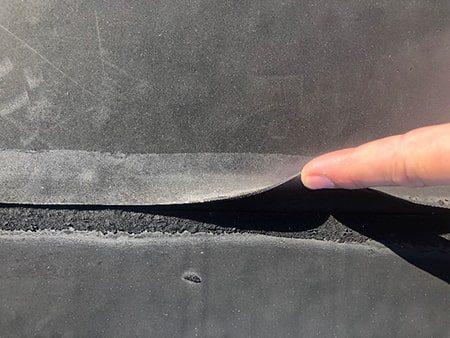
If the seams on your roof are not holding the roof together, a large percentage of your insulation is likely ruined from the excessive exposure to rainfall.
In this case, it’s not beneficial to restore your roof with silicone roof coatings.
It would be more cost-effective long-term to install a spray foam roofing system.
How much are you trying to reduce your energy savings?
Every property owner wants to save as much as possible on their energy savings. Both seamless systems provide significant energy savings.
A silicone restoration system offers a reflective coating over your existing roof. A lighter-colored roof versus a darker one could save you between 15%-35% on your energy bills.
Here is a video from the Department of Energy on reflective roof coatings:
A spray foam roofing system is a complete roofing system. Meaning the usual components of the roof are:
- Deck
- Spray foam
- Coating
- Granules
In short, the spray foam is the insulation of the roofing system. Most roofing systems use other types of insulation, such as Poly-iso board.
Spray polyurethane foam has an R-value of 6.5 per inch of thickness, which is the most of any type of roofing insulation.
Depending on a few factors, such as the current condition of your roof and the efficiency of your HVAC unit, it’s possible for a spray foam roof to provide enough energy savings (over a 5-10 year period) to pay for the installation of the entire system.
This was true for Texas A&M University in the 1980s.
Want to learn more about seamless roofing systems?
At the bottom of this section, there are links to two separate pillar pages about silicone restoration systems and spray foam roofs.
To read each article, no information is needed.
West Roofing Systems has been installing spray foam roofs since 1979, and silicone roof coating systems since 2008. In this time, we’ve heard all of the common questions that property owners ask, such as:
- How much does each system cost?
- How long does it take to install each system?
- What kind of warranty can I get with each system?
These questions are answered in the pillar pages below:
The Complete Guide to Silicone Roof Coatings
The Ultimate Guide to Spray Foam Roofing

